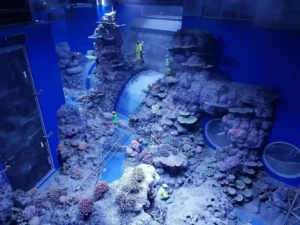Blogs
Difference in Backend Systems for Freshwater and Saltwater Aquariums
Designing a successful aquarium involves more than just choosing aquatic exhibits or setting up a visually appealing tank. A critical element lies in the backend systems that maintain water quality and ensure the health of the aquatic life within. Freshwater and saltwater aquariums each require distinct Life Support Systems (LSS) tailored to their unique requirements. This blog delves into the technical and engineering differences between the two, offering valuable insights for aquarium enthusiasts and professionals alike.
1. Understanding the Core Differences
Freshwater and saltwater aquariums differ primarily in their ecosystems, which directly influence the backend systems required to support them. Here’s a brief comparison:
- Water Chemistry: Saltwater aquariums mimic ocean environments, requiring precise salinity, pH, and mineral balances, while freshwater tanks have simpler water chemistry.
- Biodiversity: Marine aquariums often house more delicate species, necessitating advanced systems for stability.
- Filtration Needs: The filtration and circulation demands of saltwater tanks are significantly more intricate due to the sensitivity of marine life.
2. Filtration Systems: The Backbone of Aquariums
Freshwater Aquarium Filtration
- Key Components:
- Mechanical Filtration: Removes debris using sponges or filter pads.
- Biological Filtration: Utilizes beneficial bacteria to convert harmful ammonia into less toxic nitrate.
- Chemical Filtration: Activated carbon filters to remove impurities.
- Challenges:
- Algae growth due to nutrient accumulation.
- Balancing water parameters for specific freshwater species.
Saltwater Aquarium Filtration
- Key Components:
- Protein Skimmers: Essential for removing organic compounds before they break down.
- Sump Systems: Enhance water volume and stability while housing additional filtration units.
- Refugiums: Contain macroalgae or live rock to naturally filter water and maintain nutrient levels.
- Challenges:
- Managing dissolved organic compounds and maintaining a stable salinity.
- High demand for water turnover and oxygenation.

3. Water Circulation and Flow Requirements
Freshwater Aquariums
- Typically require moderate water movement to mimic natural rivers or lakes.
- Circulation is achieved using simple pumps or internal filters.
Saltwater Aquariums
- Demand dynamic water movement to replicate ocean currents, vital for corals and other marine life.
- Advanced equipment like wave makers and powerheads ensure proper circulation.
4. Lighting Systems for Freshwater vs. Saltwater
Lighting in aquariums isn’t just for aesthetics—it supports plant photosynthesis in freshwater tanks and coral growth in saltwater systems.
- Freshwater Tanks: Use full-spectrum lighting for planted tanks to encourage healthy growth.
- Saltwater Tanks: Often require specialized actinic lighting to support photosynthetic corals and enhance marine aesthetics.
5. Temperature Control: Keeping It Just Right
- Freshwater Aquariums:
- Require basic heaters to maintain stable temperatures, typically between 24-27°C (75-80°F).
- Saltwater Aquariums:
- Need precise temperature regulation with heaters and chillers to match marine species’ narrow tolerances.

6. Salinity Management in Saltwater Tanks
A critical distinction is the requirement to maintain appropriate salinity levels in saltwater aquariums.
- Specific Gravity: Ideal levels range from 1.020 to 1.025 for marine setups.
- Equipment: Hydrometers or refractometers are used to measure salinity accurately.
Freshwater tanks, in contrast, require no salinity adjustments, simplifying maintenance.
7. Materials and Tank Construction
Freshwater Aquariums
- Standard glass or acrylic materials suffice.
- Minimal wear and tear from water chemistry.
Saltwater Aquariums
- Use corrosion-resistant materials like modern clear public acrylic to withstand salt’s corrosive effects.
- Require robust sealing to prevent leaks.
8. Cost Implications
Saltwater aquariums are generally more expensive due to the complexity of the backend systems and the specialized equipment required. Freshwater tanks are cost-effective, making them a preferred choice for beginners.
9. Common Mistakes to Avoid
- Improper Filtration Setup: Neglecting the specific filtration needs of marine or freshwater tanks can lead to system failures.
- Overstocking: Placing too many fish in either type of aquarium stresses the LSS.
- Ignoring Regular Maintenance: Skimping on cleaning can upset the delicate balance in both systems.

How Peach Prime Consultancy Can Help
At Peach Prime Consultancy, we specialize in designing custom aquarium solutions, from small tanks to expansive ocean museum exhibits, covering both freshwater and saltwater systems. We specialize in budget planning and cost estimation to ensure your project stays within financial expectations. By providing a detailed breakdown of the total project cost. Our services include sustainable LSS designs, advanced filtration and temperature control, collaboration with top architects, and maintenance solutions for long-lasting aquariums. We proudly serve locations including Alexandria, Aswan, Asyut, Beheira, Beni Suef, Cairo, Dakahlia, Damietta, Faiyum, Gharbia, Giza, Ismailia, Kafr El Sheikh, Luxor, Matruh, Minya, Monufia, New Valley, North Sinai, Port Said, Qalyubia, Qena, Red Sea, Sharqia, Sohag, South Sinai, Suez, Ad Dawhah (Doha), Al Daayen, Al Khor, Al Rayyan, Al Shamal, Al Shahaniya, Al Wakrah, Umm Salal, Al Bahah, Al Jawf, Al Madinah, Al Qassim, Asir, Eastern Province (Ash Sharqiyah), Ha’il, Jazan, Makkah, Najran, Northern Borders, Riyadh, and Tabuk.










